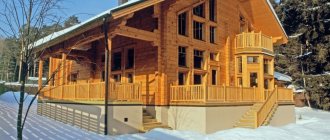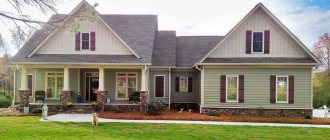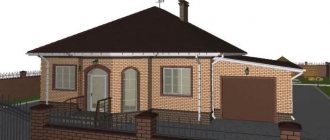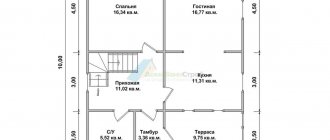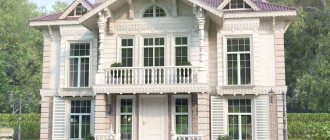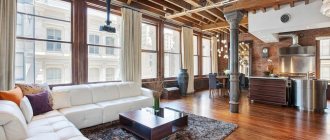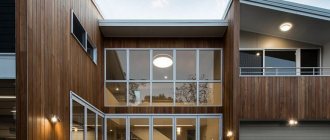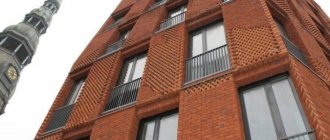Why attic? And not a full floor?
The attic involves equipment under the roof of a warm living space - instead of a cold attic. This increases the living space of a private house while maintaining its proportionality - which is difficult to achieve when building a second floor. For example, if the house is small, then the superstructure will disproportionately increase its height - with a high probability, the bulky structure will not look aesthetically pleasing. And the installation of an attic will help maintain the harmony of the architectural forms of a residential building. And it will cost the homeowner 10–15% less than creating a full second floor.
The room equipped under the roof most often has a non-standard shape, which provides unlimited opportunities for the implementation of original design ideas. A pronounced feature of the attic is the presence of inclined planes and corner areas where it is impossible to stand at full height. These disadvantages can be easily eliminated, turning them into advantages: fill the sloping corners with built-in cabinets, small bedside tables or non-standard furniture, make comfortable niches. Most often, cozy bedrooms, spacious dressing rooms, bathrooms or work rooms are installed in the attic.
History of origin
Starts from the 16th century. It was at that time that an unknown architect began to use the usable area for his needs. And he lived so well there that the rest of the townspeople adopted a similar innovation. The man's name was Francois Mansart, and since then such residential attics have come to be called attics. Their advantage was accessibility, for even the most inveterate poor man could afford to settle there. At present, of course, it makes no sense to associate attic townhouses with a lack of finances. This floor is in no way inferior, and sometimes even surpasses the others in terms of comfort.
When considering the design of a house with an attic, remember that it will give coziness and comfort to your entire family for many years.
Attic under different types of roof
Additional living space can be equipped under any of the known types of roofs - single-pitch, gable, hipped, multi-gable or traditional broken. The construction of an attic under a pitched roof should be foreseen and planned at the design stage of the house. In this case, you will not need expensive skylights that are installed on an inclined slope. Vertical walls on one or three sides under a pitched roof are glazed with standard double-glazed windows.
You can insulate a cold attic under a gable or multi-pitch roof at any stage of the house’s readiness. You can arrange a living room in it even after many years of its use. The easiest way to do this is if the roof was designed and built in advance with the possibility of creating an attic floor. And therefore it already has a classic broken shape. The construction of a rafter system with a kink is more difficult than the construction of a gable roof. But it is technically easier to equip an attic underneath, and the living space will be larger.
DIY construction instructions
It all starts with a project. In order to most competently plan the attic space and the entire house as a whole, you have to decide on important factors.
Preparing for the construction of the attic
It is necessary to select materials for construction based on the cost of purchasing the required resources. The designer’s task is to choose the most economical option. You can do the design yourself or contact a design organization.
In addition, the climatic conditions of your region are an important factor. This will directly affect the choice of materials.
You need to decide the purpose of using the attic - depending on this, it will be easier to decide what it will look like and how much it will all cost. Are you going to live in the attic year-round or seasonally? Will you use it for household needs or as a dressing room? All this will affect the cost of the project.
Useful: Construction technology and design features of a “platform” frame house
When the planning stage is over, and all decisions have already been reflected on paper or a three-dimensional model, you can begin purchasing building materials.
Attic installation
Having decided on the type of roof and having designed the future attic on paper, you can begin construction. Pay attention to the strength of the entire structure if you are adding an attic to an old frame house. Its walls and foundation may not withstand additional load , so it is better to refer to the house design and calculate what it can withstand.
The previously assembled frame is placed on top of waterproofed wooden beams. Wooden posts with a cross section of 10x10 cm are mounted on top of the beams. They are the main element of the attic. It is important to monitor the verticality of the racks during operation. To do this you need to use a level and plumb line. Then the top beam is installed, completing the assembly of the rafter frame.
The roof is attached to the Mauerlat, so it is important to install it correctly. This is necessary to protect the roof from tipping over when exposed to wind and other weather conditions. The Mauerlat is assembled from boards with a thickness of 50 cm. Installation is carried out horizontally relative to the floor.
To protect the attic from moisture, waterproofing material is used. At this stage it is placed under the boards. The boards are fastened with staples. Then, the Mauerlat is coated with a protective agent against mold and mildew to extend the life of the structure. You should always remember this stage, because wood is exposed to these factors more than other materials.
The rafter legs are fixed at a distance of one to one and a half meters from each other, starting from the front of the rafters. They are assembled on site in accordance with the attic design. The guideline for installing the rafters is the twine connecting the outer legs. It should be taut. This is done to protect against the collapse of a heavy truss structure.
If the roof of a frame house is no longer than seven meters , then a regular guy is used to connect the rafters. Then she will play the role of a beam. If the roof exceeds seven meters in length, the rafters should be connected in two pieces and the ridges of the beams should be mounted.
These beams take on loads in the form of snow, which is especially important in the northern regions.
Thermal insulation of the attic
For comfortable living in the attic of a frame house, it should be properly insulated. There are many options available for this material. All of them are equally good for both walls and roofs, which means they are suitable for insulating the attic in all areas.
The most commonly used are mineral wool and polystyrene foam . They are lightweight and easy to install. The insulation is cut to size and installed between the studs. Fastening is done with liquid nails or dowels.
Useful: What is half-timbered metal structures - design features and installation
It is worth noting that when choosing organic-based insulation, you risk getting into trouble in the form of insects and rodents.
Basalt wool is good for inclined surfaces . The material is characterized by long-term preservation of appearance and thermal insulation properties. Next, the floors are insulated. Thermal insulation material is attached between the beams. When choosing it, you should also think about sound insulation - this problem is relevant in frame houses.
Mineral wool is best used for insulating partitions. In addition to being lightweight, the material boasts fire resistance. In addition, it retains heat inside well, allowing you to save on heating costs.
Before insulation, walls must be insulated from moisture . This is also done in various ways. For example, you can use a protective film attached using wooden slats. Waterproofing is an excellent help in increasing the service life of insulation.
Windows should also be insulated from moisture. This can be done using a special foam sealant - it can provide sufficient durability to the double-glazed window. The frame must be well reinforced and have no gaps through which the wind will blow through the structure. Keep an eye on this if the installation work will be performed by a team.
Roof installation
At this stage it is necessary to ensure sufficient strength of the roof. This factor is important regardless of whether you are adding an attic to a finished house, or building an attic frame house right away. The material used is the same one that was used for the entire structure.
For a frame house, the most practical is a gable roof . This form is easier to install and retains less snow than roofs with a complex configuration.
Calculation of roof slope parameters should be entrusted to professionals if you do not have such experience. And the actual installation of the profiles will not be difficult to do yourself.
It is better to choose a material for the roof that is light, like the structure itself. You should start with the rafters. They are a “cap” made in the shape of the letter A. A film for vapor barrier is laid on them, and a thermal insulation material is attached on top. Remember to leave space for ventilation.
Drawings and calculations
Before starting the construction of an attic with their own hands in a private house, they draw up a preliminary design - make detailed drawings that clearly display the structure of the roof frame. They will help determine the sequence of construction work and correctly calculate the amount of lumber. The frame “framework” of the roof is formed by a complex of rafters with many auxiliary elements connected to each other according to certain rules - beams, timber, boards.
According to the structure of support on load-bearing walls, rafters can be hanging or layered. The first ones are installed in small houses - in spans, the width of which does not exceed 6–8 m. In them, opposite rafters are joined at the top, forming a ridge. Below they rest on the Mauerlat.
Rafters are made on layers when the width of the house exceeds 6–8 m. Then, to enhance the strength of the structure, a ridge beam is installed at the top center on supports from the main wall. All rafters are attached to it. At the bottom they also rest on the Mauerlat.
In addition to rafters, which are long wooden logs, beams or boards of large cross-section, additional elements are used to enhance the rigidity and stability of the structure:
- A tie, or tie, is a board that connects the lower ends of opposite logs, the basis of an isosceles triangle. It is installed at the bottom - the widest part of the farm. Prevents divergence of rafters, performing a tightening function.
- Crossbars are horizontal bars parallel to the screed. They are located above it, and accordingly their length is shorter.
- Purlins - horizontal beams parallel to the ridge - supports for the rafters.
- Racks and supports are located vertically.
- A bench is a horizontal wooden support for a vertical stand.
- Struts are inclined supports.
The selection of structural elements by length and cross-section, determination of the optimal pitch of the rafters is done after calculating the wind and snow loads on the roof. Lumber is produced in standard sizes, therefore, when determining their calculated values, the types of woodworking products on the market are taken into account.
Veranda roof
Note that the roof for the veranda of a house 10 by 9, as well as for all other options, should only be made sloping
- Note that the roof for the veranda of a 10 by 9 house, as well as for all other options, should only be made sloping. And as a roofing material it is better to use the same one that was used to cover the roof of the house.
- The timber of the upper trim will be used as a mauerlat. This, in turn, is mounted on vertical posts of the veranda, which are cut at an angle. Those that join the house are made higher, and those that are closer to the edge of the veranda are reduced in size in accordance with the slope of the roof.
- The rafters are attached to the frame, then sheathed with lathing.
- Later, roofing material is laid on the sheathing and covered with roofing material.
- All that remains is to decorate the veranda with nice furniture and invite friends for tea or barbecue. You and your guests will definitely love such a country house with a veranda.
Making an attic
Do-it-yourself attic equipment will cost less. In any case, this is more economical than hired labor. The manufacturing stages and the amount of materials used depend on the type of roof. The sequence of basic work is shown in step-by-step instructions:
- Drawing up a project, developing drawings.
- Construction of the rafter system.
- Installation of a roofing membrane with a ventilation gap.
- Installation of counter-lattice and sheathing.
- Laying thermal insulation.
- Protection of insulation with a vapor barrier film.
- Installation of room walls with a ventilation gap.
- Interior finishing works.
Technically, the most difficult stage is the construction of the rafter system. Before starting work, it is necessary to purchase building materials, and treat wooden elements: logs, beams, boards with fire retardants and antiseptics, allowing them to dry before installing them on the roof.
Manufacturing of rafter system
The process of manufacturing a rafter system includes several operations: laying the Mauerlat, then: assembly, installation, securing the trusses. Mauerlat is a wooden frame around the perimeter that connects the walls of the house with the roof. It has two functions - to firmly “tie” the rafter system to the house, and to evenly distribute the load from the weight of the roof. The Mauerlat is firmly secured with metal anchors. A layer of waterproofing is first laid underneath it, preventing contact of the wood with the wall material. This prevents getting wet and prevents the wood from rotting.
The technology for constructing a rafter system depends on the type of roof - single-pitch, gable, broken, hip or multi-gable. An attic can be equipped under any roof, although the best option is a gable sloping roof. This is a classic attic with a break. Because it is made up of two tiers of rafter legs: the lower ones are installed at an angle of 60°, the upper ones – 15–45°. Strength and stability of the structure are provided by vertical posts and supports, and rigidity is provided by corner struts.
Ventilation gap
A waterproofing roofing membrane is laid over the rafters, over the entire area of the slope, from bottom to top, overlapping. First, it is attached to the frame with staplers, and then pressed with counter-lattice bars, the thickness of which must be at least 50 mm. This is necessary to create a ventilation gap between the sheathing boards and the hydro-wind protection film. Free air circulation through the ventilation gap will ensure effective ventilation of the structure and timely removal of moisture from the insulation. It is also important to do this to prevent rotting of wooden elements.
Why choose a frame house with an attic?
The attic design adds aesthetics to the house, providing the opportunity to choose an unusual roof option due to its complexity. The presence of planes of different shapes distinguishes an attic house from single-story frame buildings.
Also a plus is the illumination of the room - windows at an angle let in more light , opening up opportunities for variability in design.
As a rule, it is difficult to live in such a room due to low ceilings, so the attic is used for other needs. For example, arranging a children's playroom, library or office would be perfect.
Challenges and opportunities
Construction and finishing of an attic is a rather labor-intensive process that requires the contractor to have thematic knowledge, practical skills, a set of tools, and careful adherence to technology. At the same time, any person can cope with the task independently. The implementation of the idea will allow the owner of the house to gain experience in construction and finishing work and will bring satisfaction from creative work. The complex configuration shape of the attic space provides ample scope for creativity. At minimal cost, the homeowner will receive additional meters of usable space and, as a result, an increase in the market value of the property.
Construction of attic floor walls
During the initial construction of any building, an architectural design is drawn up, which indicates the general characteristics of its structural elements. When building an attic in a wooden house with your own hands, you should take into account its features and carry out the superstructure only in permitted places and strictly in size. If you neglect the initial technical data, this threatens not only the integrity of the attic space, but also the entire building as a whole.
It is important to purchase only materials that do not ignite or emit toxic substances for the construction of attic walls. The home owner is quite capable of handling this operation on his own.
One-story house projects 9 by 9
Today, projects of one-story and two-story houses are popular. The first option is more suitable for an elderly couple, since an additional floor can be a rash decision.
A photo of a one-story house project 9 by 9 can be seen now. Due to its compactness, the owners will have additional space on the site for growing their favorite crops.
If guests arrive, there will be plenty of space in the house to accommodate them.



